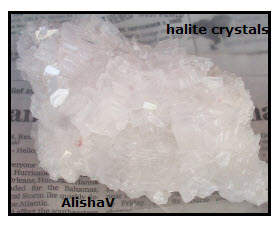 Halite is a mineral with a cubic geometric shape.
Halite is a mineral with a cubic geometric shape.
Halite crystals form when water evaporates from a sodium chloride solution. Crystals forming due to evaporation are called evaporites. Thus, halite crystals are evaporites.
Discover for Yourself
You can grow halite crystals using table salt, which is the common name for sodium chloride.
Make a saturated solution of sodium chloride.
- Use table salt without additives (iodine) and distilled water.
- Water at room temperature works as well as hot water, this is because sodium chloride’s solubility increases very little with an increase in temperature.
- The ratio of salt: water for a saturated solution is about 5 tablespoons: 1 cup.
Tips for developing a Crystal Growing Science Project
Example:
Purpose: To evaporate water from a salt solution leaving salt crystals.
Project Question: What effect does the evaporation rate of water have on the size of halite crystals ?
Project Hypothesis : In a salt solution, as the rate of water evaporation increases the size of the halite crystals decreases.
1. To design an experiment to test this hypothesis, first identify the two variables in the hypothesis.
- independent variable: the speed of water evaporation from a solution
- dependent variable: the size of the crystals
- controlled variables: These are all the things that might affect the results, so you try to keep them constant. For this experiment, they include: type of water, type of salt, concentration of salt solution, Material crystals grow on, environment.
Remember: The independent variable is what causes the dependent variable to change.
2. Decide on how you can change theindependent variable . Remember that you must be able to measure the change.
In this example, you must decide on how you can change the independent variable, evaporation rate of water, which is the amount of evaporation in a certain time.
Think!
- Heat makes water evaporate faster.
- Things get hot in sunlight.
- Wind dries things. Could have a fan blow on the tray.
- If I set the experiment outdoors, some animal might drink the water.
Example: I will put the experiment indoor on a table next to a sunny window. I will also set a fan on the table so that it blows on the water.
4. Decide on how the change in the dependent variable can be measured.
For this example, you must decide on how changes in the size of the crystals formed can be measured.
Think!
- A ruler could measure the crystals if they are big.
- But if the crystals are tiny, they could be compared. A scale from 1 to 10 could be used with the smallest crystal being 1 and largest being 10.
Answer: Since I don’t know how big the crystals will be, I’ll use a scale from 1 to 10. Also, measurement of the crystals formed by fast evaporation will be compared to the control experiment.
5. Now it is time to write the procedure, which are the steps you will follow. These steps must be clear enough for someone else to follow. Steps for both the Controlled and Testing Experiment must be ready.
- Controlled Experiment: Use procedure steps for growing halite crystals Place the tray in a cool, dark area.
- Testing Experiment: Use procedure steps for growing halite crystals plus the following steps.
Procedure: Added steps
6. Place the tray on a table near a window that receives direct sunlight.
7. Put a fan on the table so that it blows across the tray. Turn the fan on slow speed.
8. Observe the paper in the tray as often as possible until the paper is dry. This may take 5 or more days.
9. Compare the Experimental Crystals with the Controlled Crystals. Random sampling of the crystals can be made. Do this by following these steps:
- Close your eyes and randomly move the pencil around, then lower it so that it touches the paper.
- Open your eyes and make a mark on the paper.
- Using the Crystal Measuring Scale, measure the size of four crystals near the pencil mark.
- Record the crystal size measurements in a Crystal Measurement Table, such as the once shown.
Guide to the Best Science Fair Projects
(Paid Link)
